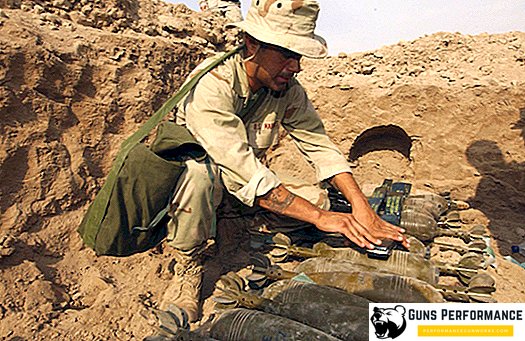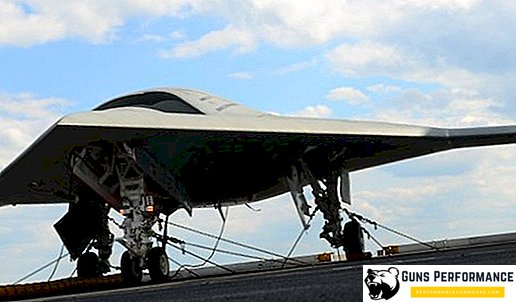
RDX or cyclotrimethylenitrinitramine (C3H6N6O6) is a powerful explosive with a high level of blistering and an acceptable level of sensitivity. Hexogen is a secondary (blasting) types of explosives (IV). It is currently one of the most used types of explosives. Refers to a group of high-energy blasting agents.
Most often hexogen is used for various military needs: equipment shells, bombs, mines, torpedoes and other ammunition. In addition, this explosive is used during blasting operations in industry, in mining, for tunneling and other engineering works. Hexogen is also used as one of the components of solid rocket fuel.
For the first time, hexogen was synthesized at the end of the nineteenth century in Germany, but large-scale industrial production of this explosive was established only during the Second World War. During this conflict, more than 100 thousand tons of RDX were produced in Germany alone.
This explosive has excellent high-explosive and blasting properties, sufficient chemical resistance and acceptable sensitivity. Therefore, it is not surprising that hexogen is the second most popular explosive after TNT. In addition, the production technology of this explosives is relatively simple and fairly cheap. The starting material for hexogen is nitric acid and hexamine, which are obtained from coal, water and air. Therefore, the production of this explosive can quite easily establish almost any state. Based on the foregoing, it becomes clear that it is not so easy to find an analog of hexogen.
In the mid-1990s, one pound of RDX cost from eight to twelve US dollars.
In Russia, the name of this explosive became widely known after the tragic events of 1999, when exactly hexogen was used to blow up residential buildings in Moscow and Volgodonsk.
Today, there are more than five ways to get RDX, all of them are suitable for large-scale production of this explosive.
Chemical and physical properties

RDX is a solid substance, in the normal state of aggregation, a white crystalline powder. It has neither taste nor smell. Strong poison: this substance affects the human nervous system, mainly the brain and can cause anemia and various circulatory disorders.
The specific gravity of this explosive is 1.816 g / cm ³, and the molar mass is 222.12 g / mol.
The density of RDX equals 1.8 g / cu. cm, the flash point is 220-230 ° C, the detonation speed reaches 8380 m / s, and the explosive transformation energy is 1290 kcal / kg. The volume of gaseous products for RDX is 908 l / kg, and the pressure in the front of the shock wave is 34.7 GPa. Brisance of this type of explosives - 24 mm, high explosiveness - 470 ml.
The TNT equivalent of RDX is 1.6, from which it becomes clear that this explosive is much more powerful than TNT.
Hexogen is non-hygroscopic, practically insoluble in water, little chemically active. It does not react with metals, it is poorly soluble in ether, alcohol, toluene, benzene and chloroform, slightly better in DMF, acetone, and concentrated acids, acetic and nitric.
Sulfuric acid, alkali hexogen decomposes, the same happens with him and when heated. The melting point of this explosive is 204.1 ° C. During this process, the sensitivity of explosives is greatly increased, therefore, the hexogen is not melted, but pressed. Although this explosive is pressed, it is also bad, so it is phlegmatized in acetone before it is processed.

Hexogen burns well, burns without residue on an open fire, explodes with rapid heating. It has a high sensitivity to mechanical stress, especially to shock. To reduce the sensitivity of this explosive is usually phlegmatized.
This explosive is especially sensitive to detonation. Hexogen has significant chemical resistance, the warranty period for storage in warehouse conditions is 20 years.
History of creation
The first explosive substance with which mankind became acquainted was black smoke powder. The exact date of his invention is unknown, but it is believed that he appeared in China as early as the VII century AD. If we proceed from this date, it should be recognized that it took mankind a little more than a thousand years to invent the second type of explosive.
The rapid development of chemistry and other exact sciences at the end of the XVIII century allowed to obtain picric acid and volatile mercury. The most successful for chemists who worked on the creation of new types of explosives, was the XIX century. In 1847, nitroglycerin was first synthesized, on the basis of which a little later, Alfred Nobel created dynamite. In 1863, the most common in our days explosives were obtained - TNT.
Hexogen was discovered at the very end of the 19th century - in 1899 by the German chemist Hans Genning. Moreover, this discovery was made completely by accident. A scientist was looking for a medicine that would help people with inflammation of the urinary tract, an analogue of urotropine already known at that time. Genning hoped that his substance would treat people even more effectively. However, it turned out a little differently.

The substance synthesized by the German chemist was not suitable for treatment, because it had serious side effects, and the doctors very quickly abandoned it. However, twenty years later (in 1920), it turned out that hexogen is the strongest explosive that is well suited for military purposes. It was superior in power to TNT, and its detonation rate exceeded all types of explosives known at that time. At first, they could not even determine the blasting of this explosive, because it simply tore up the standard lead column, which is used to determine this characteristic. The explosion of hexogen with a mass of one kilogram leads to the same destruction as the detonation of 1.25 kg of TNT.
After that, the military was immediately interested in several countries: Great Britain, Germany, the USA and the USSR. In the early 1930s, continuous plants for the production of RDX already existed in these countries. During World War II, it reached hundreds of tons per day; several new ways of synthesizing this explosive were invented.
It should be noted that the artisanal production of RDX is rather difficult, therefore, terrorists or criminal structures do not often use this explosive for their own purposes. The fact that hexogen was used for the bombings of residential buildings that occurred in Moscow and Volgodonsk, as well as for other terrorist acts in Russian cities in the late 1990s, indicates either the involvement of special services in these events or the complete destruction of the explosives control system substances.
Ways to get
Currently, there are several ways to obtain RDX, all of them are suitable for the industrial production of this explosive.
The main raw material for the production of RDX is hexamine, a medicine and substance that many people mistakenly call dry alcohol.
According to the Hertz method, urotropine was simply treated (nitrated) with concentrated nitric acid. This method had some drawbacks, the main of which is a relatively small yield of explosive (about 40%) and a significant consumption of nitric acid. Although, it must be said that the Hertz method is used today. He allows to receive RDX very high quality.
Later, other methods of obtaining RDX were developed:
- Method "K". This method was first used in Germany. It allows you to significantly increase the amount of explosives. It differs from the Hertz method by adding ammonium nitrate to nitric acid, which neutralizes the reaction by-product, formaldehyde;
- Method "KA". In this case, the hexogen is obtained in the presence of acetic anhydride. A solution of ammonium nitrate in nitric acid and hexamine dinitrate is added to it;
- Method "E". This method is also associated with acetic anhydride. Hexogen is obtained by the interaction of ammonium nitrate with formaldehyde in acetic anhydride;
- Method "W". This method was developed by Wolfram in 1934. As a result of the reaction of formaldehyde with the potassium salt of sulfamic acid, a “white salt” is obtained, which is then processed with a mixture of sulfuric and nitric acid. This method gives a very high yield of explosive - about 80%;
- Bachmann-Ross method. This method is proposed by American chemists. It is similar to the "KA", but more convenient and technological.
Using
It should be noted that in pure form this type of explosives is practically not used, since it can be dangerous for the sappers themselves. Exceptions are only some types of detonators. For equipment ammunition, as well as use in the course of blasting using a mixture based on hexogen. Most often it is interfered with along with TNT, but there may be other options.

For example, TG-50 is an alloy that contains 50% of RDX and 50% of TNT, TG-40 contains 40% of TNT and 60% of RDX, and TGA-16 contains 60% of TNT, 24% of RDX, 13% of aluminum and 3% aluminum powder. By their properties (high-explosiveness and high explosiveness), these mixtures are located between hexogen and trotyl, undernagging to pure hexogen. If we talk about the heat of the explosion, then the mixture of TGA-16 is closest to the hexogen, and according to the high-explosive effect - the mixture of TG-50.
One of the most successful mixtures based on hexogen is hexal A-1X-2. This BB contains 73% hexogen, aluminum powder and wax, which is used as a phlegmatizer. Curiously, it was a simple Soviet sailor, Yevgeny Ledin, who invented it to one of the explosives factories before the war invented this explosive. Hexal is superior to pure hexogen in its high explosive characteristics. Moreover, this explosive does not detonate even from a strong blow, which makes it possible to use it for equipping armor-piercing projectiles of naval artillery. The projectile filled with hexal did not explode when it hit the ship’s armor; detonation took place after it was broken through.
Hexogen is also one of the components of plastic explosive or, as it is also called, plastite. This explosive is a mixture of RDX and a plasticizer, which makes it soft, pliable, and sometimes even sticky. Plastites are a whole group of explosives, which include mixtures that differ in the content of the plasticizer and its type. For example, there is a plastite consisting of 88 parts of RDX and 12 parts of lubricating oil, another common plastite contains 78% of RDX and 12% of a resinous binding plasticizer. Plastite is a rather expensive explosive, it is not used to equip ammunition, as a rule, it is used to undermine various objects: bridges, pillboxes, railway tracks, metal structures. Plastites include the American C-4 explosive, which is well known to our citizens thanks to numerous Hollywood action films.
In recent years, large-scale production of IRDX has been launched in several countries of the world - the so-called low-sensitivity RDX, whose susceptibility to shock-wave action is much lower than that of a standard explosive.













